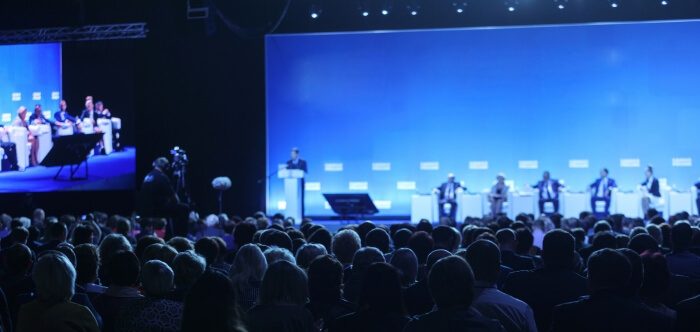The skill of communication lies not only in the content of your message but also in how you deliver it. Whether you’re leading a seminar, workshop, or a full-fledged conference, knowing the finer points of addressing your audience can make all the difference. But, how do you address people in a conference?
When addressing people at a conference, assess the formality of the event, acknowledge special guests, introduce the main theme, refer to individuals by name, and stay engaged by responding to their responses.
Remember, addressing individuals by name can improve the personal touch, especially when expecting direct feedback. Read on to learn more about mastering these finer etiquette.
Conference – What is It About?
Conferences are essential in promoting discussion, sharing knowledge, and sparking innovation. These events gather like-minded individuals, promoting collaboration and discussion. Let’s dive deeper into understanding the essence of a conference.

The term “conference” denotes a formal meeting where participants engage in discussions around specific topics or areas of interest. Typically, these gatherings allow individuals to exchange ideas, present findings, or debate differing viewpoints. It’s not simply a gathering but an organized event with a defined purpose.
While the format may vary, the core objective is to encourage interaction and understanding. Some international conference organizers develop events that showcase renowned keynote speakers, engaging breakout sessions, and hands-on workshops, each carefully crafted to provide a deep knowledge of the topic. Attendees gain fresh perspectives, acquire knowledge, and access valuable tools through these sessions.
Over time, technology has reshaped how we perceive conferences. Virtual events, supported by digital platforms, have become increasingly prevalent. Besides offering similar benefits to traditional meetings, they are also flexible and have a global reach, making knowledge distribution more accessible than ever.
Who Participates at a Conference?
Conferences serve as melting pots, bringing together diverse groups of individuals. Each participant plays a unique role, from the seasoned expert to the eager novice. Here’s a closer look at the main actors in this collaborative arena.
Keynote Speakers
Esteemed professionals often grace conferences as keynote speakers, setting the tone for the event. They provide valuable insights, share experiences, and inspire attendees with their expertise. Their event keynote speech usually highlights the central theme of the conference.
Panelists and Presenters
These individuals dive deeper into specific topics, often presenting research findings or case studies. Panelists, on the other hand, engage in discussions, offering varied perspectives on a common theme. Their sessions promote interaction and open dialogue.
Organizers and Moderators
Every successful conference has diligent organizers who make sure the event runs smoothly. They handle logistics, schedules, and coordination of addressing people, ensuring everything runs smoothly. On the other hand, moderators guide discussions, focusing on engaging conference attendees and keeping them on track and lively. This role is crucial in maintaining the event’s interactive nature.
Attendees and Delegates
General attendees make up the bulk of a conference’s audience. These individuals come to learn, network, and engage with the content presented. Delegates representing specific organizations often contribute to discussions and share feedback.
Sponsors and Exhibitors
Businesses often support conferences, viewing them as brand promotion and outreach platforms. They set up stalls or exhibition spaces, introducing their products or services. This collaboration benefits both the event and the sponsors, creating mutual value.
A conference is a dynamic ecosystem where each participant contributes to its success regardless of their role. Whether sharing knowledge, facilitating discussions, or simply soaking in new information, every individual adds a unique dimension to the event.
How Do You Address People in a Conference?
The right way to address people at conferences is essential to developing an engaging and respectful atmosphere. Whether you are attending a formal seminar or meeting casually, your greeting sets the tone. Here is a step-by-step procedure to make sure you get it right every time.
Step-1. Assess the Formality
Before diving into your address, assess the atmosphere and level of formality of the conference. In formal settings, it’s advisable to use greetings like “Good evening, ladies and gentlemen.” A simple “Good morning, everyone!” is apt for more casual environments.
Step-2. Acknowledge Special Attendees
Special guests or dignitaries often grace conferences with their presence. Always give a nod to these individuals, recognizing their importance. A brief mention or welcome can set a positive tone for the entire event.
Step-3. Provide a Brief Introduction
Every conference has a core theme or purpose. Begin by introducing the main topic or objective of the event. It provides clarity and sets the stage for subsequent discussions or presentations.
Step-4. Address Individuals by Name
When seeking feedback or asking questions, make it personal. Addressing attendees by their name grabs their attention and fosters a sense of inclusivity. It ensures direct communication and responses.
Step-5. Stay Engaging and Responsive
Engagement is a two-way street. While addressing the audience, pay attention to their reactions, which helps to engage with conference participants. Consider altering your tone or approach to regain their interest if they seem disengaged.
Knowing the right way of addressing people in a conference contributes to the overall experience and leads to meaningful connections. By following these steps, you can create a welcoming and engaging environment for all attendees.
Considerations While Addressing People in a Conference
Addressing the audience at a conference can be challenging due to its nature and complexities. Striking the right balance requires thought and tact. Here are key considerations to keep in mind:
Cultural Sensitivity
It’s imperative to be aware of cultural norms and preferences. Certain greetings may resonate well in one culture but not in another. Always research and adapt to the audience’s cultural background.
Clarity of Speech
An audience values clear and concise communication. Mumbling or speaking too quickly can lead to misunderstandings. Ensure your words are articulate and your pace is measured.
Avoidance of Jargon
Technical terms and industry jargon can alienate unfamiliar attendees. It’s pivotal to keep language accessible and relatable. Tailor your address to suit both experts and novices in the room.
Body Language
Non-verbal cues speak volumes in any setting. Maintain eye contact, use open gestures, and ensure your posture conveys confidence. Positive body language fosters trust and engagement.
Audience Engagement
A monologue seldom holds attention for long. Encourage participation, ask questions, and create interactive moments. Making your address a dialogue keeps the energy alive and dynamic.
With these considerations in mind, addressing a conference becomes more meaningful and effective. Being tuned to the audience and the environment ensures a positive and lasting impression.
Perks of Addressing People Properly at a Conference
Communication is the key to any successful conference. Your manner of addressing attendees can have a profound impact. The following are some benefits of properly addressing people at a conference:
Establishes Credibility
Proper address showcases professionalism and expertise. When speakers communicate respectfully, their credibility is elevated. Attendees then perceive them as knowledgeable and trustworthy.
Facilitates Engagement
Engaging presentations capture the audience’s attention seamlessly. By properly addressing an audience in a conference, speakers encourage an interactive atmosphere. This engagement ensures a memorable and enriching experience for all.
Promotes Networking Opportunities
First impressions significantly impact networking prospects. By addressing individuals appropriately, speakers set a positive tone. This fosters open dialogue and potential collaboration post-conference.
Enhances Learning Outcomes
Clear communication promotes better understanding. When attendees are addressed properly, comprehension improves. They absorb content more effectively, leading to Improved learning outcomes.
Reduces Misunderstandings
Effective address curtails potential confusion. By being clear and respectful, speakers minimize the risk of misunderstandings. This smoothens the flow of the conference, avoiding unnecessary hiccups.
Bolsters Speaker Confidence
Knowing how to address it boosts speaker assurance. Being well-prepared in communication techniques instills confidence. A confident demeanor further captivates the audience’s interest.
Creates a Welcoming Atmosphere
A thoughtful address makes attendees feel valued. Recognizing and speaking to attendees in a considered manner cultivates a welcoming environment. This ensures their comfort and willingness to participate.
The finer points of addressing people in conferences are more than simply following protocol. They set the stage for meaningful interactions, productive discussions, and successful outcomes. With the right approach, both the speaker and attendees can reap these countless benefits.
FAQs About How Do You Address People in a Conference?
The ability to address people professionally and engage them at a conference is critical to creating a professional and engaging atmosphere. It involves more than just greetings; it’s about connecting with your audience in a meaningful way. The following are some common conference questions and answers that provide insight into how to be effective when speaking with people.
What Role Does Tone of Voice Play in Addressing a Conference?
The tone of voice is crucial as it conveys confidence, warmth, and authority. A well-modulated tone can keep the audience engaged and ensure your message is clearly understood, while a monotonous tone might lead to disinterest.
How Can You Use Humor When Addressing a Conference?
Using humor appropriately can break the ice and make the atmosphere more relaxed. However, it should be used sparingly and relevantly to the topic to avoid misunderstanding or offending the audience.
What Are the Best Ways to Handle Interruptions During a Conference?
Handling interruptions politely and confidently is key. Acknowledge the interrupter, briefly address their concern if necessary, and steer the conversation back to the main topic, maintaining control of the discussion.
How Do You Address Technical Difficulties During a Conference?
Maintain calm and composed under pressure, acknowledge the problem, and assure the audience that a solution will be found soon. If possible, engage the audience with related content or discussion while waiting for the issue to be fixed.
What Should You Avoid When Addressing People at a Conference?
Avoid speaking too quickly, using jargon, or focusing too much on your notes. These habits can lead to a disconnection with the audience. Instead, aim for clarity, engagement, and direct communication.
Final Thoughts
Communication goes beyond words; it’s deeply linked with how you deliver them. From knowing the definition of a conference to recognizing its participants, each element plays a role in shaping the event’s success.
At the core, understanding “how do you address people in a conference?” is recognized as a crucial skill. When executed with precision, cultural sensitivity, and genuine engagement, proper address builds credibility, develops relationships, and creates an atmosphere ripe for knowledge exchange.
As we’ve explored, the approach you choose in addressing your audience doesn’t just set the tone; it determines the relevance and impact of your message, leaving a lasting impression on all attendees.







